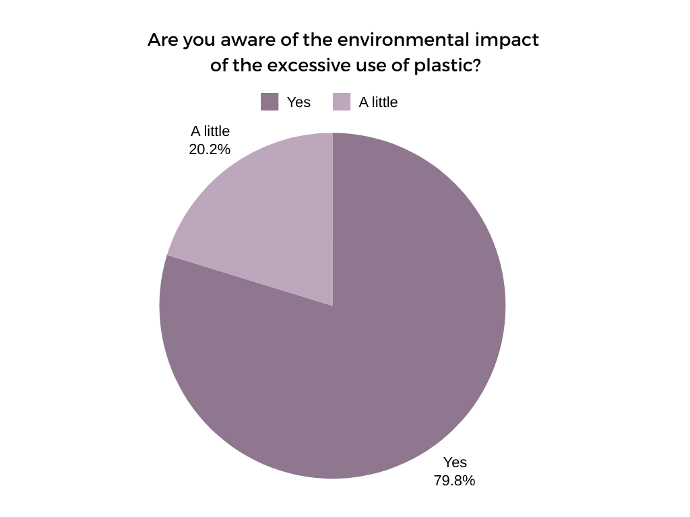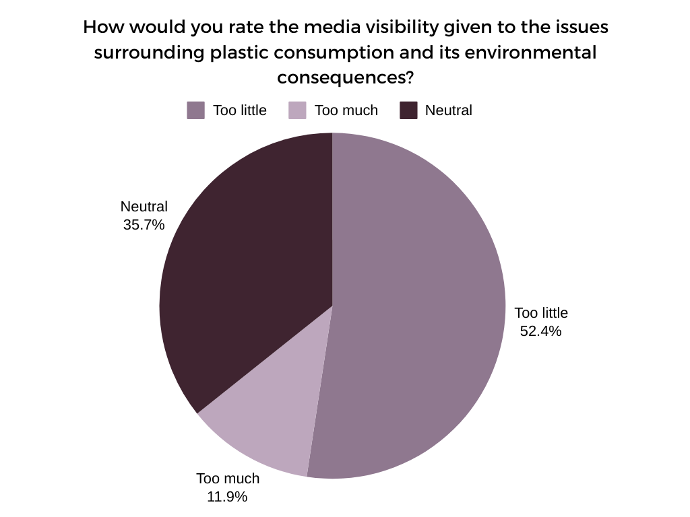Our plastic consumption has evolved over the years. Even though we are trying to consume less plastic, we reached 400 metric tons of plastic production in 2022, and only 15% was collected for recycling. However, in those 15%, plastic is once again sorted out into what can be recycled and what is going to be incinerated. By the end, only 9% of the 400 metric tons are really recycled.
Are people aware of this plastic overproduction? Are they aware of the environmental impact it causes? Are people changing their plastic consumption habits?
Consumption habits
Plastic pollution is what motivates people to consume less plastic. It’s true that plastic is endangering our health and the wild life. In some Asian and African countries, the waste collection system is nonexistent, which means that a lot of plastic waste are either thrown in illegal landfills in which it's incinerated or it's thrown in rivers. From those rivers, they can be carried to the sea. Usually they would stay in coastal waters, but if caught up in ocean currents, they could travel worldwide. Once in the ocean, plastic endangers wild life such as sea turtles and seals. We often find these animals strangled by fishing lines or with their stomachs full of plastic, which can cause death. The plastic found in the animal's stomachs is usually microplastic, which is the breakdown, over time, of larger plastic.
Microplastics have an impact on our own health too. They can break down even more to become nanoplastic and may be found in the air we breathe or in the water that we drink. These plastics were found by scientists in our bodies, such as in our blood. These can cause health issues like weight gain, a decline in reproductive health, and even cancer.

Because of all that, people nowadays are quite aware of their plastic consumption habits and use more and more plastic alternatives. Here’s a list of what people use:
- Tote bags/paper bags
- Reusable packaging
- Honey wax packaging
- Reusable straws
- Bamboo toothbrush
- Wooden or paper Q-tips
- Solid soap and/or shampoo
- Metal/glass water bottles
- Buy bulk products
- Cloth make-up remover
- Reusable hygienic pads
These alternatives are a start in reducing the environmental impact of plastic.
Media visibility
When people are asked if plastic environmental impact has enough visibility in the media, their answers are “no”. In fact, they say that there should be more visibility to make people more aware of the situation. We could promote companies, organizations and apps that actively encourage waste collection. We could also broadcast awareness-raising programs on television, radio and social medias to reach a wide audience, from young people to the elderly. Or we could use shocking pictures and heartbreaking stories to show the consequences of plastic on the environment and on our health. All of this could be done on a weekly basis to raise awareness. But for now, if we are passive over this problem, we only hear about plastic overconsumption once in a blue moon.
People want to raise awareness and make a difference but when they come across an organization’s post, 75% of them would not repost it. If those 75% would reshare those posts, it could lead to a bigger change of mindset in people’s plastic consumption. It only takes one second to share but the results could last in the long game.

__________
References
- « A Whopping 91 Percent of Plastic Isn’t Recycled ». https://education.nationalgeographic.org/resource/whopping-91-percent-plastic-isnt-recycled.
- Center, Columbia Business School-the Eugene Lang Entrepreneurship. « The Plastic Alternative The World Needs ». Forbes. https://www.forbes.com/sites/columbiabusinessschool/2022/05/17/the-plastic-alternative-the-world-needs/.
- Costigan, Michelle. « A Timeline of Plastic Pollution. From Wonder Solution to a Global Sustainability Nightmare ». Streamline, 19 mai 2022. https://www.brandedbystreamline.com/2022/05/a-timeline-of-plastic-pollution/.
- « Topic: Global Plastic Waste ». Statista. https://www.statista.com/topics/5401/global-plastic-waste/.
- Environment. « Plastic Pollution Facts and Information », 21 février 2024. https://www.nationalgeographic.com/environment/article/plastic-pollution.
- King, Colleen. « Why We Need To Understand the History of Plastic Before We Can Tackle The Problem ». Plaine Products (blog), 24 avril 2019. https://www.plaineproducts.com/why-we-need-to-understand-the-history-of-plastic-before-we-can-tackle-the-problem/.
- « Plastic pollution is growing relentlessly as waste management and recycling fall short, says OECD ». https://www.oecd.org/environment/plastic-pollution-is-growing-relentlessly-as-waste-management-and-recycling-fall-short.htm.
- « The Future of Plastic Alternatives (U.S. National Park Service) ». https://www.nps.gov/articles/000/plastic-alternatives.htm.